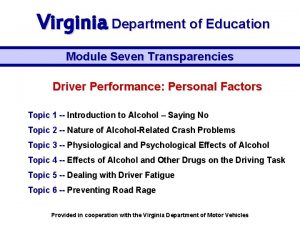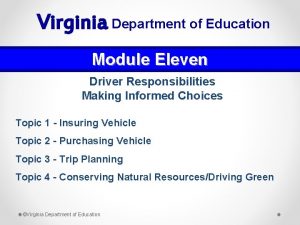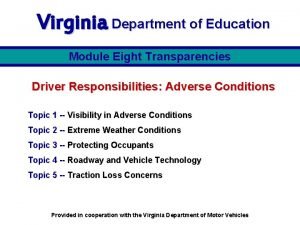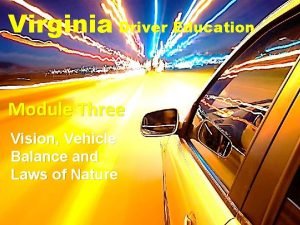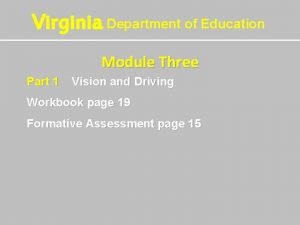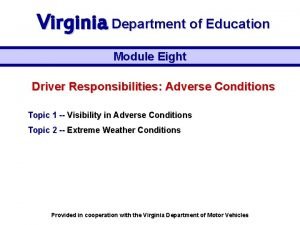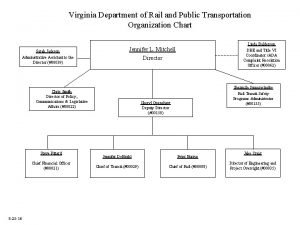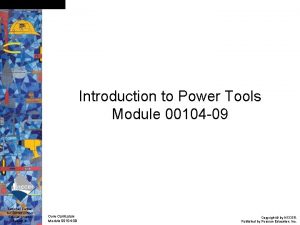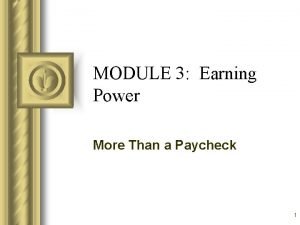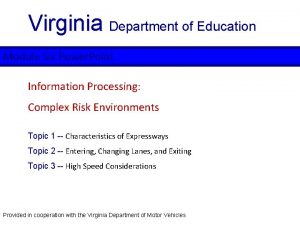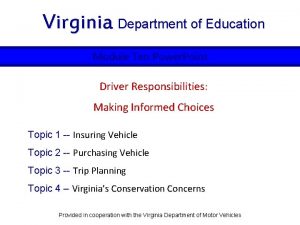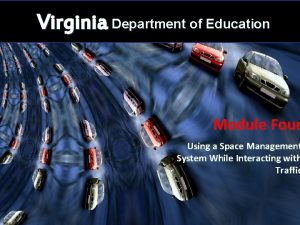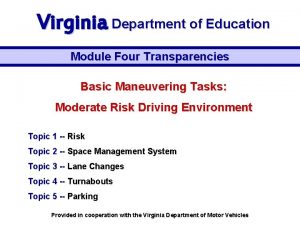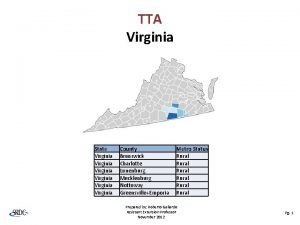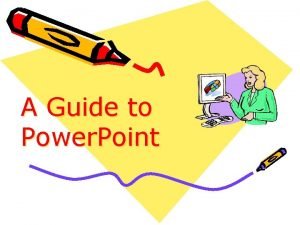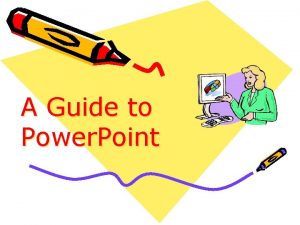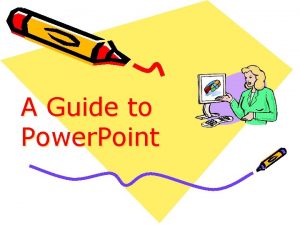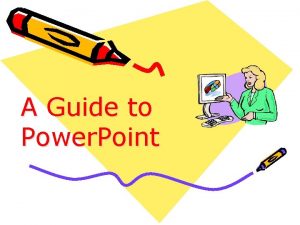Virginia Department of Education Module Four Power Point




























- Slides: 28

Virginia Department of Education Module Four Power. Point Basic Maneuvering Tasks: Moderate Risk Driving Environment Topic 1 -- Risk Topic 2 -- Space Management System Topic 3 -- Lane Changes Topic 4 -- Turnabouts Topic 5 -- Parking Provided in cooperation with the Virginia Department of Motor Vehicles

Risk • Risk is the Chance of Injury, • Chance is the probability of likelihood of a crash • Injury, Damage, or Loss Usually Are the Consequences of a Crash ex: Damage, or Loss – – – Every driver accepts a certain level of risk when driving a vehicle. Injuries to yourself or others Property damage Financial loss, loss of opportunity, loss of time Increased speed results in less reaction time, longer braking distances, and more severe collisions

Risk Assessment Elements of Risk are: • Risk Assessment • Risk Acceptance • Risk Compensation Unfortunately, drivers often create high risk situations.

Topic 1 Lesson 1 Risk Assessment Involves: • Recognizing increased risk situations -Speeding -Following Too Closely -Failure to Yield -Improper Turns -DUI -Lack of Safety belt use • Understanding the consequences of increased risk situations • Considering your options and the consequences of your choices T – 4. 3

Risk Acceptance: • There is always a certain amount of risk involved in the driving task. • How much risk is acceptable? – Evaluate Consequences of Taking Risks (Penalty, Damage, Injury or Death) Knowledge can help you reduce risk! 4 Having good seeing habits and your ability to manage space on the roadway are essential ingredients for low-risk driving. 4 To minimize risk, drivers need time, space & visibility to execute a maneuver.

Risk Assessment Risk Compensation -- Recognizing potential risk or limitations and making appropriate adjustments Example taken from Module 3 Topic 3 Lesson 1 --- RECOGNIZING high risk situations. • • • Adjust Speed to Reduce Risk Adjust Lane Position to Reduce Risk Use Appropriate Communication to Reduce Risk

Reduced Risk Driving • Three principles for reducing risks – Never risk more than you can afford to lose – Do not risk large consequences for a small reward – Consider the odds and your situation

Topic 1 Lesson 2 Reducing Driving Risk • Behaviors that increase risk • Speeding • Failure to yield right of way • DUI • Disregarding a traffic sign or signal • Following to close • Improper turns • Unsafe passing • Failure to wear safety belt • Talking on cell phone T – 4. 6

Topic 1 Lesson 2 Reducing Driving Risk • Good decision-making is essential to reducing driving risks. • Developing sound habits and judgments • Practice a space management system(seeit) • Develop good decision-making skills T – 4. 6

Topic 2 Lesson 1 Vehicle Operating Space There are seven basic areas of operating space for a vehicle. Six of the space areas (zones) are around your vehicle, and the seventh, or central space, is the space your vehicle occupies. T – 4. 12 a

Topic 2 Lesson 2 Vehicle Operating Zones Vehicle Operating Space To assist you in learning zones and their purposes we have colored and numbered each for easy identification. 3 Right-Front Zone (Maroon) Front Zone 1(Yellow) 2 Left-Front Zone (Green) Right-Rear Zone (White) Central Space Area 5 Rear Zone (Blue) Left-Rear Zone (Red) 6 4 Direction of Travel A zone refers to one of the six spaces around your vehicle. It is the width of a traffic lane and extends as far as you can see. A zone has three characteristics, it can be OPEN, CLOSED or CHANGING T – 4. 13

Topic 2 Lesson 2 Managing Zones Evaluating Your Alternatives Closed ZONE Changing ZONE Open ZONE Central Space Area Check Rear Move Here Check Side Direction of Travel OPEN — a zone that has no restrictions to the line of sight or path of travel. CLOSED — a zone not available for the vehicle’s path of travel or an area that has a restriction to the driver's line of sight. CHANGING — an open zone that may change to a closed zone. T – 4. 14

Topic 2 Lesson 3 Space Management Basics Searching : • Where to Look • What to Look for • How to Evaluate Evaluating Conditions: • Risk Potential of a Closed or Changing Areas Versus • Risk Potential of Alternative Areas T – 4. 15

Topic 2 Lesson 3 Space Management Basics Where to look The area outlined in blue represents your field of vision extending from THE DRIVER to the intended target area. Path of Travel Proper search and actions consists of the: • • • 4 to 8 -second range — Immediate Action Required 12 to 15 -second range —Allows for Escape Routes 20 to 30 second range to the target area — Safe and open path of travel T – 4. 15 a

Topic 2 Lesson 3 Space Management Basics What to Look for Path of Travel A driver must constantly search for potential risks and determine consequences. T – 4. 15 b

Topic 2 Lesson 3 Space Management Basics How to Evaluate Path of Travel ã ã Will the motorcyclist enter your path of travel? How can the driver of the red vehicle reduce risks? T – 4. 15 c

Topic 2 Lesson 3 Space Management Basics Executing Decisions: • • Change speed while maintaining vehicle balance Change position while maintaining vehicle balance Risk Reduction: • Control the Target Area, Line of Sight and Path of Travel by: • speed changes; • position changes; and • effective communication. What is the best decision and action for the driver of the RED car? T – 4. 16

Topic 2 Lesson 3 Space Management Basics Open, Closed, or Changing Zones • A red traffic signal is … • A parked car to your right is … • A bicyclist to your right is … • A vehicle in your left mirror blind area is … • A motorcycle in your right mirror blind area is … • A large truck following closely behind is … T – 4. 17

Topic 3 Lesson 1 Turning at Intersections • Right Turn • Approach to Intersection • Prepare for turn 200 -300 ft before turn • Communication Target • Turn signal, position, and tapping brake • Target Areas • Path of Travel • Slow down before you turn • Line of Sight • Begin accelerating when your LOS is 20 seconds ahead • Speed Adjustment • Begin accelerating at the apex of the turn • Lane Position • Turning Reference Point • Begin turning when the side view mirror appears to be even with the curb • Steering • Hand-to-hand steering T – 4. 18

Topic 3 Lesson 1 Turning at Intersections • Left Turn • • • Approach to Intersection Communication Target Areas Path of Travel Line of Sight Speed Adjustment Lane Position Turning Reference Point Courtesy Considerations T – 4. 19

Lane Changes • Why change lanes? Visual checks for lane change to the LEFT. • check zones ahead (zones 1 and 2) • check zones to the rear (zones 4 and 6) • Slow moving vehicles • Obstructions • Lane ends • Turn required • Construction BLIND SPOT Visual checks for lane change to the RIGHT. • check zones ahead (zones 1 and 3) • check zones to the rear (zones 5 and 6) BLIND SPOT • Communicate lane changes by using turn signals. T – 4. 20

Turning Around Two-Point Turns Your visual reference point for backing: the driver should begin steering into the driveway when the line of sight from the driver to the edge of the driveway runs through the center of the back passenger window 1 Back into driveway on right side • • • Check traffic flow. • Straighten wheels, centering car in driveway and stop with the wheels straight. • Signal left and exit driveway when the way is clear. 2 Signal and position the vehicle 2 -3 feet from curb. Drive beyond the driveway and stop. Shift to Reverse, monitor intended path of travel. Back slowly, turning steering wheel rapidly to the right as you enter driveway. 3

Topic 4 Lesson 1 Turning Around Two-Point Turns Pull into driveway on left side • • 1 Check traffic flow. Signal and position your vehicle 3 -6 inches from center yellow line. When traffic is clear, pull into the driveway and stop. Shift to Reverse, monitor intended path. Back slowly, turning steering wheel rapidly to the right as you exit driveway. Straighten wheels, centering car in proper lane. Shift into Drive. Check traffic and accelerate to normal speed. 2 3 T – 4. 25

Topic 4 Lesson 1 Turning Around Three-point Turn 2 4 1 3 • • • Approach Communication Target Areas Path of Travel Line of Sight 5 • References • Speed Control • Lane Position • Courtesy Considerations NOTE: The safest way to change direction is to drive around the block! T – 4. 26

Angle Parking at a 30 Degree Angle to the Curb ü Signal intention and position vehicle 3 -5 feet from the space in which the vehicle is to be parked. üApproach parking space 2 -3 feet away. üVisually target the middle of the parking space and turn the wheel sharply at a slow, controlled speed. ü begin to steer when the side mirror appears to align with the first line of the space. üYou should use hand to hand/pushpull steering.

Perpendicular Parking at a 90 Degree Angle to the Curb ü Approach the space 5 – 7 feet away. ü Target the center of the space. ü Begin steering when the side view mirror appears to align with the first line of the parking space. ü Steer towards the target using hand to hand/push-pull steering and straighten the wheels. ü Position the front bumper 3 – 6 inches from the curb.

Parallel Parking Parallel to the Curb ü Select a space that is at least five feet longer than your vehicle. Flash your brake lights and put on your turn signal as you approach the space. ü Monitor the traffic to the rear. ü Place your vehicle 2 – 3 feet from the vehicle you want to park behind with back bumpers even. ü Put your vehicle in Reverse. Back slowly and turn the steering wheel sharply. ü Stop when your steering wheel is aligned with the back bumper of the front vehicle. ü Continue backing slowly while steering sharply in the opposite direction. Use quick glances to the front and rear. ü Center the vehicle in the space. Wheels should be 6 – 12 inches from the curb. T – 4. 29

Hill Parking When parking on a hill, you need to take special precautions to ensure your vehicle will not roll into the street and into traffic. Down Hill with or without a curb Up Hill with a Curb Up Hill without a Curb • Approach • Communication • Target Areas • Path of Travel • Line of Sight • Speed Adjustment • Lane Position • Reference Points • Courtesy Considerations
 Module 10 drivers ed virginia
Module 10 drivers ed virginia Drivers ed module 7
Drivers ed module 7 Module 11 topic 1 insuring a vehicle
Module 11 topic 1 insuring a vehicle Module 8 topic 1 drivers ed
Module 8 topic 1 drivers ed Module 3 topic 2 vision and driving
Module 3 topic 2 vision and driving Lane position 1-4
Lane position 1-4 Module 5 curves hills and mountains
Module 5 curves hills and mountains Module 8 topic 1
Module 8 topic 1 Northern virginia seo
Northern virginia seo The real lesson 21
The real lesson 21 Power bi training powerpoint
Power bi training powerpoint Point point power
Point point power Virginia department of agriculture and consumer services
Virginia department of agriculture and consumer services Virginia department of historic resources database
Virginia department of historic resources database Virginia department of rail and public transportation
Virginia department of rail and public transportation Virginia department for the blind and vision impaired
Virginia department for the blind and vision impaired C device module module 1
C device module module 1 Important water features of virginia
Important water features of virginia A porta-power® is an example of a(n)
A porta-power® is an example of a(n) Module 00104 introduction to power tools
Module 00104 introduction to power tools The power of laughter module c
The power of laughter module c Module 3 earning power
Module 3 earning power Tiffany taylor georgia department of education
Tiffany taylor georgia department of education Ryan roemerman
Ryan roemerman Oklahoma alternative placement program
Oklahoma alternative placement program School education and literacy department
School education and literacy department Government of karnataka department of technical education
Government of karnataka department of technical education Gde mission and vision
Gde mission and vision Gde vision and mission
Gde vision and mission

